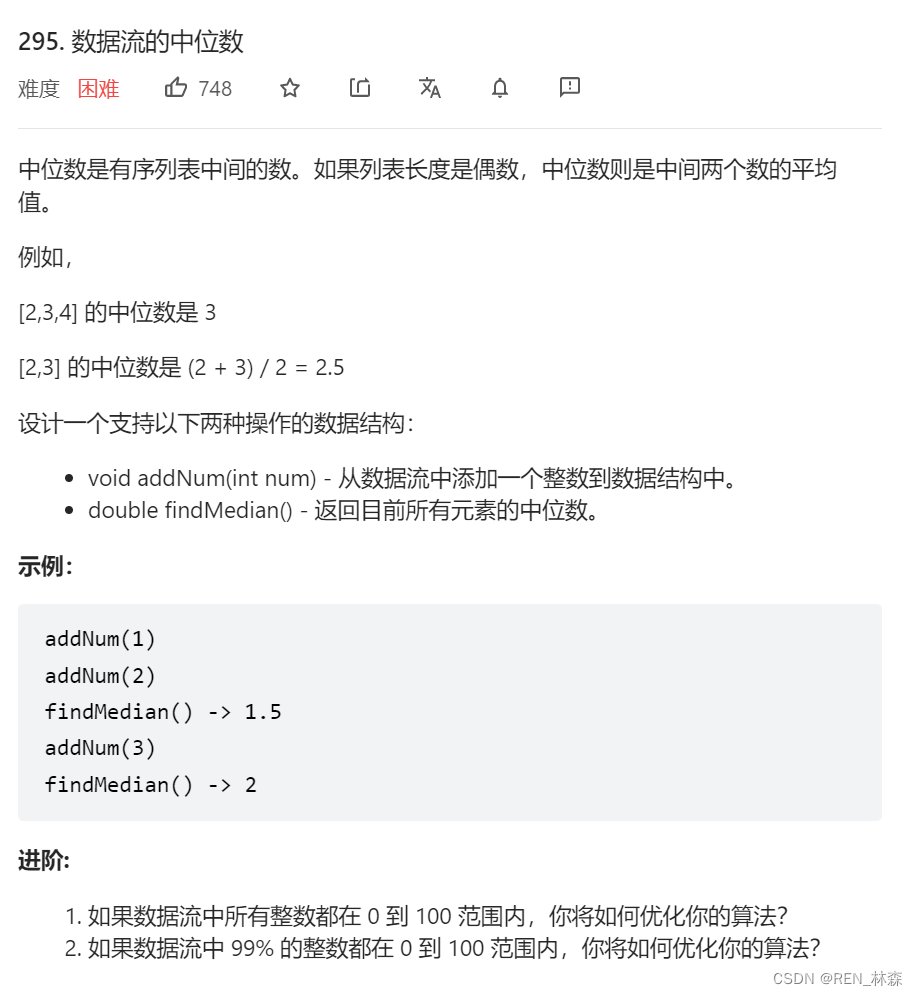-
数据流的中位数 [双堆&桶的使用]
前言
在不断添加元素的情况下,获取数据中的中位数,可以中一分为二,将两边分别放在大小顶堆中;也可用TreeMap进行桶排,结合中位双指针来快速获取中位数。
一、数据流的中位数

二、双堆 & 桶
1、大小顶堆
// 数据流的中位数。 // 做不来,看来官方题解的提示部分,马上积极思考,双队列如何做。 // 做不来,先看提示 -> 独立思考 -> 学习别人沉淀的东西(尤其是优秀楼主,有独立思考,不看优秀者的总结,得不到升华;无独立思考,看了也是白看,get不到。) public class MedianFinder { // 采用双优先队列,一个大顶堆(存左边)+一个小顶堆(存右边),保持2个队列size差1即可。 PriorityQueue<Integer> bigTopQue = new PriorityQueue<>((p, q) -> q - p); PriorityQueue<Integer> smallTopQue = new PriorityQueue<>(); public MedianFinder() { } public void addNum(int num) { if (bigTopQue.isEmpty()) bigTopQue.add(num); else if (smallTopQue.isEmpty()) smallTopQue.add(num); else { int[] nums = new int[3]; // 将3数排序。 sort(nums, bigTopQue.poll(), num, smallTopQue.poll()); // 分发最大和最小数。 bigTopQue.offer(nums[0]); smallTopQue.offer(nums[2]); // 根据情况分发中间的数。 if (bigTopQue.size() <= smallTopQue.size()) bigTopQue.offer(nums[1]); else smallTopQue.offer(nums[1]); } } private void sort(int[] nums, int m, int num, int n) { nums[0] = m; nums[1] = num; nums[2] = n; Arrays.sort(nums); } public double findMedian() { int total = bigTopQue.size() + smallTopQue.size(); int value = smallTopQue.peek(); if ((total & 1) == 1) return value; return (bigTopQue.peek() + value) / 2d; } }- 1
- 2
- 3
- 4
- 5
- 6
- 7
- 8
- 9
- 10
- 11
- 12
- 13
- 14
- 15
- 16
- 17
- 18
- 19
- 20
- 21
- 22
- 23
- 24
- 25
- 26
- 27
- 28
- 29
- 30
- 31
- 32
- 33
- 34
- 35
- 36
- 37
- 38
- 39
- 40
- 41
- 42
- 43
- 44
- 45
2、TreeMap+双指针
// 类似于计数排序。非重复N个桶。 class MedianFinder2 { // 用TreeMap来排序,用双指针来记录左右中位数。 TreeMap<Integer, Integer> tm = new TreeMap<>(); // 第一位指向中位数,第二位指向重复中位数的第N个。需要根据N的大小来判定是否需要ceiling/flooring! int[] left = new int[2]; int[] right = new int[2]; public MedianFinder2() { } public void addNum(int num) { tm.put(num, tm.getOrDefault(num, 0) + 1); // 当容器为空时,将左右指针指向同一个元素,且是该元素的第一个值(重复情况)。 int size = tm.size() - 1; if (size == 0) { left[0] = right[0] = num; left[1] = right[1] = 1; } // 当容器个数为偶数时,再根据num和left[0]/right[0]的大小来完成left/right数组的修改。 else if ((size & 1) == 0) { // num在中间,则left需前进。 if (left[0] < num && num < right[0]) increase(left); // num在left的左边,right-- && left应该和right指向同一个位置。 else if (num <= left[0]) { decrease(right); // 防止left[0] == num,将num插在left[0]指向数的后面。 System.arraycopy(right, 0, left, 0, 2); } // num 在right的右边,将left++即可。 else increase(left);// 当right[0] == num时,插右边无影响,所以无需arraycopy } // 当容器个数为奇数时,两指针指向同一个元素,即right == left。 else { // 当num < left[0]时,left--即可。 if (num < left[0]) decrease(left); // 当num >= left[0]时,即大于right[0]时,直接right++即可。 else increase(right); } } private void decrease(int[] iter) { if (--iter[1] == 0) { iter[0] = tm.floorKey(iter[0] - 1); iter[1] = tm.get(iter[0]); } } private void increase(int[] iter) { if (++iter[1] > tm.get(iter[0])) { iter[0] = tm.ceilingKey(iter[0] + 1); iter[1] = 1; } } public double findMedian() { return (left[0] + right[0]) / 2.0; } }- 1
- 2
- 3
- 4
- 5
- 6
- 7
- 8
- 9
- 10
- 11
- 12
- 13
- 14
- 15
- 16
- 17
- 18
- 19
- 20
- 21
- 22
- 23
- 24
- 25
- 26
- 27
- 28
- 29
- 30
- 31
- 32
- 33
- 34
- 35
- 36
- 37
- 38
- 39
- 40
- 41
- 42
- 43
- 44
- 45
- 46
- 47
- 48
- 49
- 50
- 51
- 52
- 53
- 54
- 55
- 56
- 57
- 58
- 59
- 60
- 61
- 62
总结
1)仔细分析问题,利用合适的数据结构来解决问题。除此之外,大小顶堆可快速获取最大/最小元素,对数级别。
2)TreeMap,以Key为比较对象,除了能O(1)的获取指定元素,还能配合ceiling/flooring来获取指定元素的左右元素。
3)做不来,看来官方题解的提示部分,马上积极思考,双队列如何做,养成积极思考的习惯的同时,也不忘学习他人,节约时间。
4)做不来,先看提示 -> 独立思考 -> 学习别人沉淀的东西(尤其是优秀楼主,有独立思考,不看优秀者的总结,得不到升华;无独立思考,看了也是白看,get不到。)
参考文献
[1] LeetCode 数据流的中位数
-
相关阅读:
SAP 教程之 SAP 中的 IDOC
深入浅出落地应用分析:AI数字人「微软小冰」
ROS学习笔记06、ROS常用组件(TF坐标变换、rosbag、rqt工具箱)
【Java】应用层协议HTTP和HTTPS
C语言自定义类型讲解:结构体,枚举,联合(2)
推荐几款优秀的项目报表软件
第5篇 vue的通信框架axios和ui框架-element-ui以及node.js
GoFrame+Vue+ElementUI通用后台管理系统
GPT家族
6seg*4com 段码LCD液晶显示驱动IC-VK1024B SOP16 少脚位1621,具省电模式,常用于充电器/美容仪等
- 原文地址:https://blog.csdn.net/qq_43164662/article/details/126735773